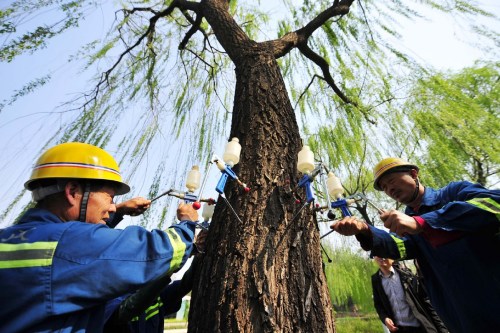
Workers inject chemicals into a willow to limit catkin production in Beijing's Xicheng district on Tuesday. (YUAN YI/FOR CHINA DAILY)
Beijing plans to use new poplar trees it has developed to replace more than 500,000 of the current trees, which release catkins in massive amounts every spring.
With temperatures rising recently, masses of willow and poplar catkins-pollinating flowers-have begun blowing throughout the city, which can cause problems with traffic and complicate the lives of street cleaners and people with allergies.
Kang Xiangyang, a professor specializing in tree breeding at Beijing Forestry University, led a research team to successfully develop the new type of poplar.
"They have passed legal approval at the national level and are ready to enter the market," he said.
Poplars and willows produce catkins as part of their reproduction process. Most of the current trees in the city are female, which leads to masses of catkins.
"The new type of poplars are male, and can grow as fast as the female ones. This means they can help the city to achieve a greening effect soon," Kang said.
He said that simply removing the existing trees wouldn't solve the problem.
"It requires a process to replace the trees," he said.
The Beijing Municipal Landscape and Forestry Bureau said on Monday that it plans to treat 300,000 willow and poplar trees in a variety of ways this year, including chemical injection, trimming and thinning, to limit catkin production. The city has about 2 million of the trees, the bureau said.
Du Jianjun, deputy head of the bureau's science and technology office, said the city has stopped planting female poplars and willows.
High-pressure water jets will be used to reduce floating catkins, and officials have asked the urban cleaning department to clear away the debris in a timely manner.
Sun Jinlyu, a doctor at Peking Union Medical College Hospital, said during a forum that the number of people who suffer from pollinosis has reached 50 million worldwide.
"In Beijing, one-third to one-fourth of the patients have allergic responses to pollen," he said.
Willows and poplars account for 5.4 percent of the city's trees, according to the bureau.
Liu Xiuchen, a consultant for the State Council who has worked in the gardening and landscape industry for decades, said that in the 1950s the government had limited money for landscaping in the capital, so the low-cost and fast-growing poplars and willows became the best choice at that time and were widely planted.


















































